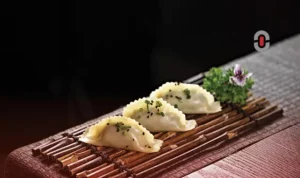Food is a universal necessity, yet our perception of it is shaped by factors far beyond the physical act of eating. One of the most powerful forces influencing our experience of food is language. Whether it’s the words used to describe a dish, the language spoken during a meal, or the cultural connotations embedded in certain culinary terms, language plays an essential role in how we perceive and enjoy food.
The Power of Descriptive Language In Food Perception
Descriptive language has the power to influence our perception of taste, enhance our culinary experiences, and drive the success of food marketing campaigns. When these descriptions cross-cultural and linguistic boundaries, translation becomes a critical element in preserving the “glamour” and appeal of food.
The language used to describe food significantly affects how we perceive its taste and quality. Words that evoke sensory details – such as “crispy,” “tender,” “juicy,” or “zesty” – do more than convey the physical characteristics of food. They create mental images and expectations that can enhance the overall dining experience. This is particularly evident in situations where the consumer hasn’t yet tasted the food – the description itself can generate anticipatory pleasure, influencing how the food is actually experienced when consumed.
For example, consider the difference between a menu listing “Grilled Chicken” and one that offers “Herb-Marinated Grilled Chicken with a Smoky Char and Citrus Zest.” The longer option paints a graphic picture in the mind, suggesting a complex and delightful flavor profile. Studies have shown that when food is described with rich, sensory-laden language, people tend to rate it higher in taste and overall satisfaction, even if the food itself hasn’t changed.
Challenges In Translating Food Descriptions
Translating food descriptions is a complex and nuanced task that goes far beyond finding the literal equivalent of words in another language. It involves capturing the essence, cultural significance, and sensory appeal of a dish while making it accessible and enticing to a different audience. The process is full of challenges, stemming from linguistic differences, cultural nuances, and the inherent subjectivity of taste and texture. Below are some of the key challenges faced in translating food descriptions.
1. Linguistic Equivalence and Nuance
One of the primary challenges in translating food descriptions is finding linguistic equivalents that convey the same meaning and emotional impact as the original language. Food terms often carry connotations that are deeply embedded in the culture of the source language, making it difficult to find direct translations.
For example, the Japanese term umami refers to a savory taste that is distinct from the basic tastes of sweet, salty, sour, and bitter. While “savory” might be used in English, it doesn’t fully capture the complexity and specific taste sensation that umami conveys in Japanese. Similarly, words like “crisp” and “crunchy” in English might both translate to the same term in another language, but they evoke slightly different sensory experiences in the original context.
2. Cultural Connotations and Expectations
Different cultures have unique ways of perceiving and valuing tastes and textures, which are reflected in their culinary vocabulary. Translators should be aware of these cultural connotations to accurately convey the intended meaning and appeal of a dish.
For instance, in Chinese cuisine, the texture described as 滑 (huá), meaning “slippery” or “smooth,” is often considered a positive attribute, particularly in dishes with tofu or jellyfish (that’s right, jellyfish – some species are a source of food and ingredient in Chinese cuisine for over 1,700 years). However, in cultures where this texture is not commonly appreciated, describing a dish as “slippery” might evoke negative reactions. The challenge lies in finding a description that communicates the intended positive qualities while aligning with the cultural preferences of the target audience.
3. Lost in Translation: Untranslatable Terms
Some food-related terms are so culturally specific that they have no direct equivalent in other languages. These “untranslatable” terms present a unique challenge for translators, who must find creative ways to convey the meaning or leave the term untranslated and provide an explanation.
An example is the Italian term al dente, which describes the ideal texture of pasta when it is firm to the bite. While the phrase can be translated as “to the tooth,” this literal translation does not fully capture the specific culinary meaning that is so well understood in Italian culture. In such cases, translators may choose to retain the original term and offer a brief explanation, such as “cooked al dente, with a firm texture.”
Case Studies From Asian Culture
1. Japanese Umami
The term umami was first coined by Japanese chemist Kikunae Ikeda in 1908, who identified it as a distinct taste separate from the traditional four tastes of sweet, salty, sour, and bitter. Umami is derived from the Japanese word umai (うまい), meaning “delicious” or “pleasant,” combined with the suffix mi (味), meaning “taste.”
Umami is often described as a deep, savory taste that is rich and mouth-filling, typically associated with foods that are high in glutamates, such as ripe tomatoes, soy sauce, Parmesan cheese, mushrooms, and cured meats. It is characterized by a certain roundness and lingering depth on the palate, which enhances the overall flavor of a dish and provides a satisfying sense of fullness.
In Western culinary traditions, the word “savory” generally refers to flavors that are not sweet, often associated with saltiness and spiciness. It is a broad term used to describe foods that are rich, hearty, and satisfying. While “savory” does overlap with umami in some respects, it lacks the precision and specificity that umami conveys in Japanese.
2. Freshness And Texture In Chinese Cuisine
 In Chinese cuisine, freshness is not just a desirable quality; it is often considered essential to the integrity of a dish. The concept of xiān (鲜), which means “fresh,” is a central tenet in Chinese food culture. It encompasses not only the literal freshness of ingredients, such as recently caught fish or just-picked vegetables, but also a broader sense of vitality and purity in food.
In Chinese cuisine, freshness is not just a desirable quality; it is often considered essential to the integrity of a dish. The concept of xiān (鲜), which means “fresh,” is a central tenet in Chinese food culture. It encompasses not only the literal freshness of ingredients, such as recently caught fish or just-picked vegetables, but also a broader sense of vitality and purity in food.
Texture, or kǒugǎn (口感), plays an equally important role in Chinese culinary traditions. The Chinese language has a highly developed vocabulary for describing textures, which are often considered as important as, if not more important than, flavor. For instance, terms like nèn (嫩, tender), cūn (脆, crispy), huá (滑, slippery), and jīn (筋, sinewy or chewy) are commonly used to describe the precise texture of foods.
In translation, however, the significance of these terms can be lost. English lacks the same specificity when it comes to freshness and food textures. The English translations might fail to capture the subtle differences that are crucial in Chinese food descriptions.
3. Vietnamese Cuisine
In Vietnamese cuisine, certain ingredients and preparation methods hold deep cultural significance, often tied to specific regions, traditions, or historical contexts. For example, dishes like phở, bánh mì, and bún chả are not just foods; they are cultural icons that embody the history and identity of Vietnam. For instance, phở is often translated simply as “noodle soup,” but this translation fails to capture the complexity and cultural importance of the dish. Phở is a symbol of Vietnamese street food culture, with regional variations that reflect the diversity of the country.
4. Thai Cuisine
Thai food is known for its complex flavor combinations, where multiple taste sensations are carefully balanced in a single dish. The language used to describe these flavors is often nuanced, with specific terms that do not have direct equivalents in English.
For example, the word priao (เปรี้ยว) means “sour” in Thai, but it can refer to a range of sourness depending on the ingredient used, such as lime juice, tamarind, or vinegar. Each source of sourness brings its own unique flavor profile to a dish. Translating priao simply as “sour” may not convey the full depth and complexity of the flavor.
Similarly, khem (เค็ม) means “salty,” but in Thai cuisine, it might also imply a certain richness or depth that comes from ingredients like fish sauce or soy sauce. These ingredients add not just saltiness but also a layer of umami that can be lost in translation.
Conclusion
The relationship between language and taste is a testament to the complexity of our sensory experiences. Words do more than just describe food—they shape our expectations, influence our sensory perceptions, and even connect us to cultures and traditions. As we navigate through different culinary landscapes, the language we use becomes an essential tool in translating and enhancing our experience of taste. Whether through vivid descriptions, cultural connotations, or the subtle nuances of sound, language transforms food from mere sustenance into an art form, enriching our lives one bite at a time.
